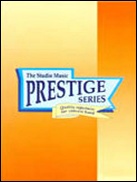Results
-
 £19.95
£19.95CAMBRIAN SUITE (Prestige Concert Band Extra Score) - Ball, Michael
Extra Score. This suite - originally a brass band work - was commissioned jointly by the Black Dyke Band and the Brass Band Heritage Trust. The composer later made this version for concert band. The work is intended to be played without a break but divides naturally into three sections. Each section is based upon a traditional Welsh melody treated in free variation manner, respectively Gwyr Harlech (Men of Harlech), Suo-Gan (Cradle Song) and Codiad Yr Hedydd (The Rising of the Lark). There is a momentary reference to Yr Deryn Pur (The White Bird) at the end of the second section. (Grade 4) Performance time: 12:00 Recorded on Polyphonic QPRM152D MOSAIC: Great British Music Vol. 13
Estimated dispatch 7-14 working days
-
 £99.95
£99.95CAMBRIAN SUITE (Prestige Concert Band Set) - Ball, Michael
Score and Parts. This suite - originally a brass band work - was commissioned jointly by the Black Dyke Band and the Brass Band Heritage Trust. The composer later made this version for concert band. The work is intended to be played without a break but divides naturally into three sections. Each section is based upon a traditional Welsh melody treated in free variation manner, respectively Gwyr Harlech (Men of Harlech), Suo-Gan (Cradle Song) and Codiad Yr Hedydd (The Rising of the Lark). There is a momentary reference to Yr Deryn Pur (The White Bird) at the end of the second section. (Grade 4) Performance time: 12:00 Recorded on Polyphonic QPRM152D MOSAIC: Great British Music Vol. 13
Estimated dispatch 7-14 working days
-
 £154.99
£154.99Celtic Concertino Wind Band Set (Score & Parts) - Fraser, Bruce
This little concerto for clarinet was written for Peter Holligan , a friend of its composer, and the Fife Youth Concert Band (Scotland). The work was based on traditional Celtic music, and consists of three movements. 1. Reel - a fast dance ending in an atmospheric but virtuoso cadenza. 2. Lament - a slow and melancholy song hinting at the sound of bagpipes. 3. A fast and virtuoso dance in 6/8 time with Irish influence. The work is a wonderful audience-pleaser and an absolute 'must' for all clarinet-players. The band too is called upon and by all means does have its part to play in the piece. Band grade 4, soloist grade 5. Dit Concertino voor klarinet werd geschreven voor Peter Holligan , een vriend van de componist, en de Fife Youth Concert Band (Schotland). Het werk is gebaseerd op de traditionele Keltische muziek, en bestaat uit drie delen. 1. Reel - een snelle dans die eindigt in een sfeervolle, maar virtuoze cadens. 2. Lament - een trage en melancholische melodie die het geluid van doedelzakken verbeeldt.3. Een snelle en virtuoze dans in 6 / 8 maatsoort met Ierse invloeden. Voor het publiek een heerlijk werk om naar te luisteren en een uitdaging voor de solist(e)! Het orkest ondersteunt deze om het tot een kleurrijk geheel te maken! Orkest graad 4, solo graad 5. 10:00
Estimated dispatch 7-14 working days
-
 £89.99
£89.99Down by the Salley Gardens Wind Band Set (Score & Parts)
A thoroughly gripping melody of Irish descent constitutes the basis on which this exceedingly beautiful little piece of music rests. Down by the Salley Gardens is a guaranteed heartbreaker on your next concert. Since the lyrics of this Irish traditional are also supplied with the set, a combination of band with solo voice or even choir is a definite possibility. The Arranger: Leafing through a song-book containing traditionals etc., I was immediately struck by this song and its exceptionally beautiful and atmospheric melody. 03:30
Estimated dispatch 7-14 working days
-
 £88.00
£88.00EUPHONIUM MUSIC (Euphonium/Concert Band) - Bowen, Brian
Something of a classic in its brass band and piano versions. Written in 1978, the work is constructed in three movements and is virtually a concerto for euphonium and band. The first movement begins with an unaccompanied motto theme, which uses all twelve notes of the scale but with a tonal feel. The slow second movement is based on an original song melody by the compsoer - The Eyes of God - and affords lyrical and richly expressive playing that is typically euphonium. movement three follows without a break - a capricious movement which ends triumphantly. Duration: 15:00 American Grade 5
Estimated dispatch 7-14 working days
-
 £60.99
£60.99God rest ye merry Gentlemen Wind Band Set (Score & Parts)
God rest ye merry, Gentlemen' is an ancient English carol. It was first published in 1833, but it can be traced as far back as the 15th century, which makes it one of the oldest carols known. 'God rest ye merry' is a Middle English salutation. In this manner, people wished one another greatness and might. In modern English, the first line of this carol would read 'May God keep you mighty, gentlemen'. Andrew R. Mackereth has not kept to the original words in his up-tempo arrangement of the carol. It is still clearly recognizable, but the arranger has taken a good many liberties. Sometimes a particular note is held longer, at times motifs follow one another in various parts. If you listen carefully, you may even be able to detect a motif from another well-known song. 01:45
Estimated dispatch 7-14 working days
-
 £49.50
£49.50Let There Be Peace On Earth
A beautiful arrangement of one of the most memorable melodies of all time that makes a wonderful concert piece for any middle school band. Starts out quietly featuring the woodwind section (and optional choir or audience sing-a-long) and then the brass takes over and builds to a big full sound. Great piece to combine choir and band as the finale of your concert. A great message in a great song! Inspiring and impressive!
Estimated dispatch 7-14 working days
-
 £43.56
£43.56Mi Casa Es Su Casa (Concert Band - Score and Parts)
Based on the traditional folk song Home Sweet Home, this musical setting provides a wonderful opportunity for your developing percussion section to perform on a variety of Latin instruments. Castanets, claves, maracas and vibraslap are all utilized to help provide a rhythmic energy behind a beautiful and lyrical theme. All of your students, including parents, will thank you many times over for programming this selection. A real showstopper!
Estimated dispatch 7-14 working days
-
 £76.99
£76.99Night Disco (Concert Band - Score and Parts)
What could be better than a night out on the town? Luc Gistel obviously thought nothing! This entertaining composition has plenty of sounds that will remind young and old of many a night spent in the disco. After a tune that even John Travolta himself would have danced to, the mood quiets down for the obligatory slow song, during which new couples and old lovers can dance a little closer. Then things heat up again until the wee hours of the morning... 05:25
Estimated dispatch 7-14 working days
-
 £164.95
£164.95OMAGGIO (Novello Symphonic) - Ball, Michael
Score & Parts. Omaggio is a homage to Italy and all things Italian. A brief Burla of a fast-moving scherzo character pays tribute to Verdi. Barcarola is sterner stuff - a grim black gondola evokes the Venice of the Serenissima. The movement is an actual gondola song coupled with the jaunty fanfares of Monteverdi and Gabrieli's Sonata pian'e forte. The most substantial movement is the final Palio, an unashamedly programmatic evocation of the historic Sienese horse-race, ending with a Tuscan folk-song. Duration: 16-18 mins
Estimated dispatch 7-14 working days
